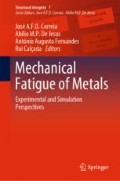Abstract
Plasticity Induced Crack Closure (PICC) has been studied by means of finite element method for a long time. Most of previous work was developed considering bi-dimensional models. During last years, the use of three-dimensional models has been extended. Nevertheless, the methodology employed has been inherited from bi-dimensional analyses. Many previous bi-dimensional analyses studied different numerical parameters and optimized them. Present computational capabilities allow a comprehensive study of the influence of different modelling parameter in a similar way to those bi-dimensional analyses. Moreover, the influence of these parameters on the obtained results along the thickness can be taken into consideration. In particular, one of the key issues is related to the crack growth scheme. A fatigue analysis implies a crack growth. Each change in loading and boundary conditions implies solving a nonlinear problem. It is not feasible to consider all the cycles involved in a real fatigue problem when running a finite element analysis. The computational cost is not acceptable. In the present work, a CT aluminium specimen has been modelled three-dimensionally and several calculations have been made in order to evaluate the influence of the number of load cycles between node releases. The results are analysed in terms of crack closure and opening values.
Access this chapter
Tax calculation will be finalised at checkout
Purchases are for personal use only
References
Newman JC (1974) A finite-element analysis of fatigue crack closure. NASA Tech Memo X-72005
McClung RC, Sehitoglu H (1989) On the finite element analysis of fatigue crack closure-1. Basic modeling issues. Eng Fract Mech 33:237–252
Branco R, Antunes FV, Martins RF (2008) Modelling fatigue crack propagation in CT specimens. Fatigue Fract Eng Mater Struct 31:452–465
Gonzalez-Herrera A, Zapatero J (2009) Numerical study of the effect of plastic wake on plasticity-induced fatigue crack closure. Fatigue Fract Eng Mater Struct 32:249–260
Antunes FV, Camas D, Correia L, Branco R (2015) Finite element meshes for optimal modelling of plasticity induced crack closure. Eng Fract Mech 142:184–200
Chermahini RG, Shivakumar KN, Newman JC Jr, Blom AF (1989) Three-Dimensional aspects of plasticity-induced fatigue crack closure. Eng Fract Mech 34:393–401
Vor K, Gardin C, Sarrazin-Baudoux C, Petit J (2013) Wake length and loading history effects on crack closure of through-thickness long and short cracks in 304L: Part II—3D numerical simulation. Eng Fract Mech 99:306–323
Lopez-Crespo P, Camas-Peña D, Gonzalez-Herrera A, Yates JR, Patterson EA, Zapatero J (2008) Numerical and experimental analysis of crack closure. Key Eng Mater 385–387:369–372
Camas D, Lopez-Crespo P, Gonzalez-Herrera A (2011) Numerical study of the influence of the crack front curvature in the evolution of the plastic zone along the CT specimen thickness. Key Eng Mater 465:119–122
Camas D, Lopez-Crespo P, Gonzalez-Herrera A, Cruces AS, Moreno B (2016) Study of fatigue cracks with numerical and experimental methods. Procedia Eng 160:13–20
Camas D, Lopez-Crespo P, Gonzalez-Herrera A, Moreno B (2017) Numerical and experimental study of the plastic zone in cracked specimens. Eng Fract Mech 185:20–32
Camas D, Garcia-Manrique J, Moreno B, Gonzalez-Herrera A (2018) Numerical modelling of three-dimensional fatigue crack closure: mesh refinement. Int J Fatigue 113:193–203
Camas D, Garcia-Manrique J, Gonzalez-Herrera A (2011) Numerical study of the thickness transition in bi-dimensional specimen cracks. Int J Fatigue 33:921–928
Camas D, Garcia-Manrique J, Gonzalez-Herrera A (2012) Crack front curvature: influence and effects on the crack tip fields in bi-dimensional specimens. Int J Fatigue 44:41–50
Garcia-Manrique J, Camas D, Gonzalez-Herrera A (2017) Study of the stress intensity factor analysis through thickness: methodological aspects. Fatigue Fract Eng Mater Struct 40:1295–1308
Acknowledgements
This work has been supported by the Ministerio de Economía y Competitividad of the Spanish Government through grant reference MAT2016-76951-C2-2-P.
Author information
Authors and Affiliations
Corresponding author
Editor information
Editors and Affiliations
Rights and permissions
Copyright information
© 2019 Springer Nature Switzerland AG
About this paper
Cite this paper
Camas, D., Garcia-Manrique, J., Antunes, F.V., Gonzalez-Herrera, A. (2019). Numerical Analysis of the Influence of Crack Growth Scheme on Plasticity Induced Crack Closure Results. In: Correia, J., De Jesus, A., Fernandes, A., Calçada, R. (eds) Mechanical Fatigue of Metals. Structural Integrity, vol 7. Springer, Cham. https://doi.org/10.1007/978-3-030-13980-3_20
Download citation
DOI: https://doi.org/10.1007/978-3-030-13980-3_20
Published:
Publisher Name: Springer, Cham
Print ISBN: 978-3-030-13979-7
Online ISBN: 978-3-030-13980-3
eBook Packages: EngineeringEngineering (R0)

